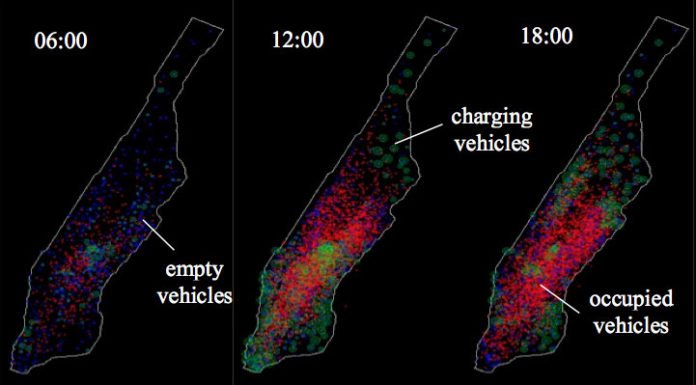Scientists at the UC Berkeley have developed a new model that could analyze taxi trips provided by shared automated electric vehicles in Manhattan. It involved color coding system where blue light represents an empty vehicle, green light is charging, and red light is occupied.
Scientists actually used the data from more than 10 million taxi trips in New York City. They found that shared automated electric vehicles, or SAEVs, could take care of business at a lower cost – by a request of extent – than exhibit day taxis while additionally lessening ozone-depleting substance emanations and vitality utilization.
Additionally, they found that “range tension” is debatable on the grounds that littler autos with a small battery-run were adequate to finish the excursions, albeit all the more charging stations would be required.
Jeffery Greenblatt, co-author of the study said, “The EV industry is focusing on the personal care market, trying to make the range as large as possible. The standard now is 200 miles. We suspected you wouldn’t need as much for taxis. We found plenty of times during the day when a portion of taxis could slip off to recharge, even if just for a few minutes. This greatly reduces the need to have a big battery and therefore drives down cost. It is dependent on having a fairly dense charging network.”
Originally, the model is an agent-based model that simulate the movement of 7,000 taxis around Manhattan throughout the day. As scientists reported, it would reduce greenhouse gas emissions by 73 percent and energy consumption by 58 percent compared to a fleet of automated conventional gas-powered vehicles.
Gordon Bauer of UC Berkeley’s Energy said, “Manhattan currently has about 500 chargers for public use, which include Tesla chargers. We found that we would need to at least triple that capacity.”
Greenblatt points out that there are still many barriers to the wider penetration of personal EV ownership, including high cost and limited range. “By switching to a shared fleet that’s automated, you can provide electric service to people essentially now,” he said.
He notes that shared vehicles are best suited for dense, urban environments: “We’re not saying these shared vehicles will be the right thing for road trips, but for the vast majority of urban trips, people drive short distances,” Greenblatt said.
The researchers said they were motivated to study this topic because they think it will be “the next big thing” in transportation, Greenblatt said.
“For a long time, personal transportation seemed like the hardest problem to solve,” Gerke said. “Now suddenly it seems like there’s an obvious path to achieving it, which is the electrification of vehicles coupled with changing the way we get around from private vehicle ownership to shared approaches. Shared approaches are starting to work in urban areas.”
Gerke previously researched lighting efficiency and was surprised by how quickly the market switched from incandescent to LED bulbs. “It was a better product and it was cheaper overall,” he said. “When you have those together, people adopt it really fast. I suspect there will be a similar transformation that will occur in the transportation sector in the next decade – it will occur faster than people think.”
Their study, “Cost, Energy, and Environmental Impact of Automated Electric Taxi Fleets in Manhattan,” was published recently in the journal Environmental Science & Technology. The corresponding author is Gordon Bauer of UC Berkeley’s Energy and Resources Group, and co-authors are Jeffery Greenblatt and Brian Gerke of Berkeley Lab.
